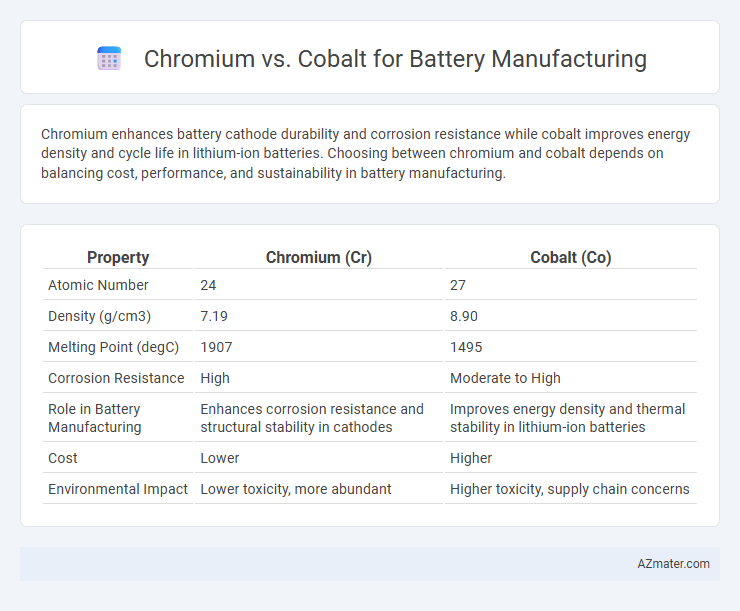Chromium enhances battery cathode durability and corrosion resistance while cobalt improves energy density and cycle life in lithium-ion batteries. Choosing between chromium and cobalt depends on balancing cost, performance, and sustainability in battery manufacturing.
Table of Comparison
| Property | Chromium (Cr) | Cobalt (Co) |
|---|---|---|
| Atomic Number | 24 | 27 |
| Density (g/cm3) | 7.19 | 8.90 |
| Melting Point (degC) | 1907 | 1495 |
| Corrosion Resistance | High | Moderate to High |
| Role in Battery Manufacturing | Enhances corrosion resistance and structural stability in cathodes | Improves energy density and thermal stability in lithium-ion batteries |
| Cost | Lower | Higher |
| Environmental Impact | Lower toxicity, more abundant | Higher toxicity, supply chain concerns |
Introduction to Chromium and Cobalt in Battery Manufacturing
Chromium and cobalt are critical transition metals used in battery manufacturing to enhance performance and safety. Cobalt is widely utilized in lithium-ion batteries for its high energy density and thermal stability, particularly in cathode materials like lithium cobalt oxide (LCO). Chromium's role is emerging, mainly as a dopant to improve battery longevity and corrosion resistance in cathode structures, contributing to the advancement of next-generation battery technologies.
Chemical Properties and Roles in Batteries
Chromium enhances battery stability and corrosion resistance due to its ability to form a protective oxide layer, improving the longevity of battery components. Cobalt significantly increases energy density and thermal stability in lithium-ion cathodes by stabilizing the crystal structure during charge-discharge cycles. The distinct chemical properties of chromium and cobalt determine their specialized functions: chromium primarily fortifies battery durability, while cobalt boosts electrochemical performance.
Energy Density: Chromium vs Cobalt
Cobalt offers higher energy density in batteries due to its superior electrochemical properties, enabling longer-lasting and more efficient energy storage compared to chromium. Chromium's lower energy density limits its use primarily to battery stability and safety enhancements rather than capacity performance. Innovations in battery technology aim to reduce cobalt dependency by incorporating chromium to maintain energy density while improving cost-effectiveness and resource sustainability.
Cost Comparison and Market Availability
Chromium offers a lower cost alternative compared to cobalt, which remains one of the most expensive materials in battery manufacturing due to its scarcity and complex extraction process. Market availability of chromium is significantly higher, supported by abundant global reserves and stable supply chains, while cobalt faces supply constraints, primarily sourced from geopolitically sensitive regions like the Democratic Republic of Congo. This disparity impacts overall battery production costs and drives research into reducing cobalt dependency in favor of chromium-enhanced cathode materials.
Safety and Stability in Battery Applications
Chromium enhances battery safety by improving thermal stability and reducing the risk of overheating in lithium-ion cells, making it a key element in high-performance cathodes. Cobalt contributes to battery stability by maintaining structural integrity under cycling conditions, but its toxicity and cost raise safety and sustainability concerns. Balancing chromium's thermal benefits with cobalt's electrochemical stability is crucial for developing safer, longer-lasting batteries in electric vehicles and consumer electronics.
Environmental Impact of Chromium and Cobalt Mining
Chromium and cobalt mining each present significant environmental challenges, with cobalt extraction often linked to extensive soil and water contamination due to toxic waste runoff. Chromium mining can lead to hazardous hexavalent chromium pollution, posing severe risks to ecosystems and human health through groundwater infiltration. Sustainable battery manufacturing increasingly prioritizes reducing reliance on cobalt and chromium to mitigate these environmental impacts and promote greener supply chains.
Ethical Sourcing and Supply Chain Considerations
Chromium and cobalt are critical materials in battery manufacturing, but cobalt's ethical sourcing challenges, including child labor and unsafe mining conditions primarily in the Democratic Republic of Congo, raise significant supply chain concerns. Efforts to improve cobalt traceability and promote responsible sourcing through initiatives like the Responsible Minerals Initiative highlight the industry's focus on transparency and sustainability. Chromium, less controversial in ethical sourcing, provides a more stable supply chain though its role in battery technology is less prominent compared to cobalt.
Performance in Lithium-Ion and Next-Gen Batteries
Chromium enhances lithium-ion battery stability by improving structural integrity and resistance to degradation under high temperatures, contributing to longer battery lifespan and safer performance. Cobalt plays a critical role in increasing energy density and maintaining high voltage output, making it essential for current lithium-ion chemistries but faces supply and ethical challenges. Emerging next-generation batteries explore reduced cobalt content while leveraging chromium's durability to balance performance, cost, and sustainability.
Future Trends and Research Directions
Emerging research in battery manufacturing highlights the potential of cobalt alternatives such as chromium to address supply chain volatility and ethical concerns associated with cobalt mining. Chromium-based cathodes show promising improvements in thermal stability and cycle life, positioning them as viable candidates for next-generation lithium-ion batteries. Future developments focus on optimizing chromium doping techniques and integrating advanced electrolyte formulations to enhance overall battery performance and sustainability.
Conclusion: Choosing Between Chromium and Cobalt
Choosing between chromium and cobalt for battery manufacturing depends on balancing cost, performance, and sustainability. Chromium offers enhanced corrosion resistance and lower cost, making it suitable for improving battery lifespan and affordability. Cobalt provides superior energy density and stability, but its higher price and ethical sourcing concerns lead manufacturers to seek alternatives or reduced cobalt content.

Infographic: Chromium vs Cobalt for Battery Manufacturing
 azmater.com
azmater.com